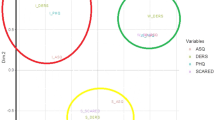Abstract
The relationship between extreme social changeand the psychological adjustment of adolescentsundergoing such change was examined. The impact ofextreme social change relative to other conditions ofcatastrophic social disorganization such as chronic socialconflict and violent war-like conditions was alsoconsidered. The results indicate that Bedouinadolescents in Israel, members of a community that hasexperienced drastic social upheaval, show elevated rates ofpsychopathology. Comparisons of Bedouin adolescents toPalestinian adolescents from the West Bank and Gazasuggest that for older adolescents the impact of extreme social change on mental healthadjustment generally parallels that of both chronicsocial conflict (West Bank) and that of violent war-likeconditions (Gaza). However, this pattern did not hold for younger adolescents. In the Bedouincommunity, younger adolescents demonstratedsignificantly less adverse impact on adjustment thanolder adolescents, while such differences did not holdin the West Bank and Gaza. Thus the findings suggest acontinuum of adverse impact of the types of socialdisorganization examined and a possible interactionbetween type of social disorganization and organismicvariables such as age and gender.
Similar content being viewed by others
REFERENCES
Bilu, Y. (1989). The Other as a nightmare: The Israeli-Arab encounter as reflected in children’s dreams in Israel and the West Bank. Political Psychology, 10(3), 365–389.
Chambon, A. (1989). Refugee families experiences: Three family themes— family disruption, violent trauma and acculturation. Journal of strategic and systemic therapies, 8, 3–13.
Chatty, D. (1986). From camel to truck: The Bedouin in the modern world. New York: Vantage Press.
Chelala, C. A. (1990). Central America: The Cost of war. The Lancet, 335, 153–154.
Collins, B.E. (1974). Four components of the Rotter Internal External Scale: Belief in a difficult world, a just world, a predictable world, and a politically responsive world. Journal of Personality and Social Psychology, 29, 381–391.
Daoud, I. (1972). Changes in the Israeli Arab family. In Louis Miller (Ed.), Mental health in rapid social change. (pp. 171–179). Jerusalem: Jerusalem Academic Press.
Derogatis, L.R., (1983). SCL-90R Scoring and Procedures-Manual II(rev. ed.). Towson, MD: Clinical Psychometric Research.
Dull, R.T. (1983). An empirical examination of the anomie theory of drug use. Journal of Drug Education, 13, 49–58.
Elbedour, S. (1992). The psychology of children of war. Unpublished thesis. Minneapolis, Minnesota.
Elbedour, S.; ten Bensel, R. & Maruyama, G. M. (1993). Children at risk: Psychological coping with war and conflict in the Middle East. International Journal of Mental Health, 22, 33–52.
Eth, S., & Pynoos, R.S. (Eds.). (1985). Post-traumatic stress disorder in children. Washington, D.C.: American Psychiatric Press.
Fields, R. (1987, October). Terrorized into terrorist: Sequelae of PTSD in young victims. Paper presented at the meetings of the Society for Traumatic Stress Studies, New York, N.Y.
Garbarino, J., & Kostelny, K. (1993). Children’s response to war: What do we know? In L. Leavitt (Eds.), The psychological effects of war and violence on children. (pp. 23–39), Hillsdale, NJ: Lawrence Erlbaum.
Garmezy, N. (1986). Commentary— Children under severe stress: critique and commentary. American Academy of Child Psychiatry, 25, 384–392.
Haddad, Y. (1980). Palestinian women: patterns of legitimation and domination. In K. Nakhleh & E. Zureik (Eds.), The Sociology of the Palestinians: New York: St. Martin’s Press.
Jakubowska, L. A. (1985). Urban Bedouin: Social change in a settled environment. Unpublished Dissertation. New York: State University of New York.
Kinzie, J.D., Sack, W.H., Angell, R.H., Manson, S., & Rath, B. (1986). The Psychiatric effects of massive trauma on Cambodian children. The Children’s Journal of the American Academy of Child Psychiatry, 25, 370–376.
Lewando-Hundt, G. A. (1979). Tel-Sheva: A planned Bedouin village. In A. Shmuelli, Y. Gradus (Eds.), The land of the Negev(pp. 666–672). Tel-Aviv: Ministry of Defense Publishing House.
Masalha, S. (1993). The effect of prewar conditions on the psychological reactions of Palestinian children to the gulf war. In L. Leavitt (Eds.), The psychological effects of war and violence on children. (pp. 131–142), Hillsdale, NJ: Lawrence Erlbaum.
Naggan, L., Forman, M. R., Sarov, B., Lewando-Hundt, G., Zangwill, L. Chang, D., & Berendes, H. W. (1991). The Bedouin infant feeding study: Study design and factors influencing the duration of breast feeding. Paediatric and Perinatal Epidemiology, 5, 428–444.
Pederson, S. (1975). Psychoanalysis in our time. New York: Macmillan.
Pines, R. (1989, January). Why do Israelis burn out? The role of the intifada. Paper presented at the International Conference on Psychological Stress and Adjustment, Tel Aviv, Israel.
Realmuto, G. M., Masten, A., Carole, L. F., Hubbard, J., Groteluschen, A., & Chhun, B. (1992). Adolescent survivors of massive childhood trauma in Cambodia: Life events and current symptoms. Journal of Traumatic Stress, 5, 589–599.
Rotter, J.B. (1966). Generalized expectancies for internal versus external control of reinforcement. Psychological Monographs, No. 1 (Whole No. 609).
Salzman, P. C. (1980). When nomads settle: Processes of sedentarization as adaptation and response. New York: Praeger Scientific.
Rights and permissions
About this article
Cite this article
Elbedour, S., Slyck, M.R.V. & Stern, M. Psychosocial Adjustment in Middle Eastern Adolescents: The Relative Impact of Violent vs. Non-Violent Social Disorganization. Community Ment Health J 34, 191–205 (1998). https://doi.org/10.1023/A:1018797103648
Issue Date:
DOI: https://doi.org/10.1023/A:1018797103648




